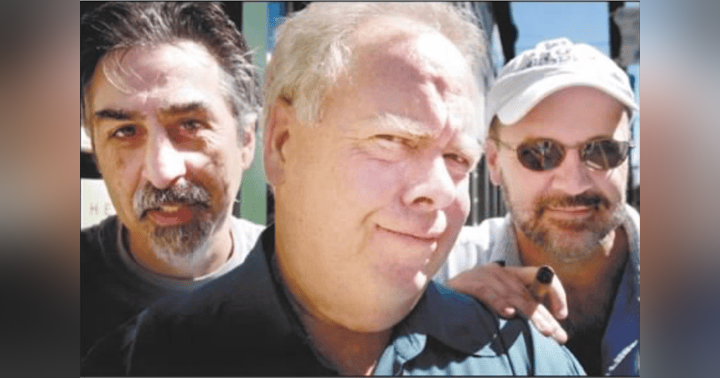
Above, John Barrymore's oblong grave marker at Mount Vernon Cemetery in North Philadelphia.
After many years of being unmarked, the oblong was finally placed there largely due to the efforts of local Barrymore buff Mark Apfel. Below left is a photo of Mr. Apfel at the Drew-Barrymore family plot, published in the Philadelphia Inquirer in May of 1992. The photo accompanied an item about his efforts to place a permanent marker on the actor's grave. Another local theater history buff, David Wren, was also pictured (below, right) in another Inquirer article from 1997, advocating for better treatment of the Drew and Barrymore family monuments, one of which had toppled over.
We covered the complicated family history of the Drew and Barrymore families earlier on the podcast. See our blog posts about them, for more details.
Episode 18: https://www.aithpodcast.com/blog/Louisa-Lane-Drew-blog-post-and-bibliography-for-episode-18/
Episode 19: https://www.aithpodcast.com/blog/mrs-john-drews-arch-street-theatre-blog-post-and-bibliography-for-episode-19/
A photo of John Drew Barrymore, c. 1985:
Here is a handy guide to the generations of the Barrymore Family at least, which I found in an online search. It seems to have been made around 1990 or so, when the actress Drew Barrymore was in her late teens or early 20s. Of the three wives of her father, John Barrymore Jr., only the third, Ildko Jaid, is shown. His son John Blythe Barrymore III, who apparently accompanied John Jr on his Philadelphia trip to properly inter Barrymore Senior, is not shown either.
Above, the mansion at 5700 City Line Avenue, for many years the residence of the Catholic Archbishops of Philadelphia. This was the spot where John Jr. was detained by Philadelphia Police in December 1980.
It is no longer in the possession of the Archdiocese, however, having been sold to St. Joseph's University in 2012.
Before we end this post, it's perhaps to remember that we should not just remember this story for its sad and semi-farcical ending. John Barrymore, in his prime, was truly a great theater artist and his memory is worthy of our respect.
He was such a vivid personality that he inspired other theater artists to attempt to capture him. Even in his own lifetime, he was portrayed (in fictionalized form) as "Tony Cavendish" in the 1927 Kaufman and Ferber play The Royal Family. There have been several modern-day shows about the actor, including Paul Rudnick's 1991 comedy/drama I Hate Hamlet. In Philadelphia, the city of his birth, there was a one-man play entitled Barrymore, written and acted by Will Stutts (below). It was produced in the upstairs studio space of the Walnut Street Theatre in 1995.
Below, a famous photo of John Barrymore as Hamlet on Broadway in 1922.
(This can't be the production that Orson Welles saw, however, as he was just seven years old and living in Chicago at the time.)
This production of Hamlet had an extended run and was enormously successful for Barrymore - a financial boon that the actor soon squandered. But at least the success was memorialized in the wonderful Al Hirschfeld cartoon:















